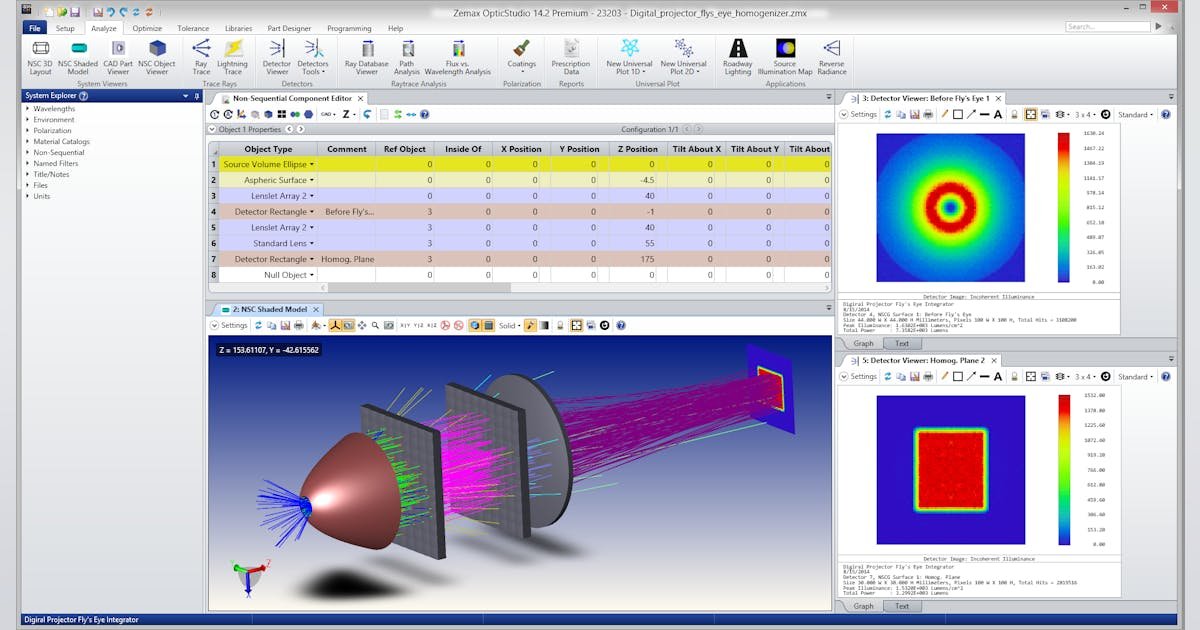Optical device design is undergoing a significant transformation thanks to advanced software tools. Historically, engineers relied on manual calculations and physical prototyping, a process that was time-consuming, resource-intensive, and often yielded imperfect results. Today, optical design software is streamlining the process, offering faster and more precise calculations along with the ability to simulate designs prior to physical creation. This shift is particularly impactful in biomedical optics, where the complexity of systems demands accuracy and efficiency.
Designers in the field now have access to a range of software options from companies like Breault Research Organization and Synopsys. To understand the impact of these tools, BioOptics World spoke with experts including Professor José Sasián from the University of Arizona, developer Paul Lutus of the open-source platform OpticalRayTracer, and representatives from commercial software providers such as Lambda Research (TracePro), Photon Engineering (FRED Optical Engineering Software), and Zemax (OpticStudio).
Professor Sasián emphasizes the growing importance of software proficiency in optics. He notes that graduates entering the field will find themselves in collaborative environments where optical design and analysis software are essential tools. While these programs offer visually appealing graphics, he stresses that truly leveraging their potential requires dedicated learning and a strong foundation in optics and lens design principles.
Rich Pfisterer of Photon Engineering describes their FRED software as a virtual prototyping tool. He points out that the traditional hardware development process can be costly and uncertain. FRED allows for rapid and accurate software simulations, making it a valuable and cost-effective solution for biomedical applications development across various devices like endoscopes, microscopes, cameras, and zoom lenses. The software functions as a 3D computer-aided design platform specifically for light propagation analysis within complex geometries.
Akash Arora, product manager at Zemax, highlights the versatility of OpticStudio, stating it can be used for nearly any application involving optics, from contact lenses and retinal research to laser systems across diverse industries. Pfisterer adds that users can build intricate models using basic shapes or import CAD files, and define complex light sources and optical properties like coatings and scattering effects. This enables simulations of phenomena like light scattering in skin, fluorescence in biological samples, or thermal emission from tissue, and supports sophisticated modeling of systems such as optical coherence tomography (OCT) and flow cytometry.
According to Arora, the primary function of these software tools is to simulate optical systems, minimizing the need for physical prototypes during the initial design phase. Once a design is finalized in OpticStudio, the software generates detailed schematics and drawings specifying dimensions and tolerances necessary for manufacturing. This data can also be converted into CAD formats compatible with CNC machines, directly facilitating the production of optical components. However, Arora underscores that a strong understanding of optics principles, including ray tracing, significantly enhances a user’s ability to effectively utilize the software.
Software performance is also tied to hardware capabilities. While OpticStudio can run on standard computers, enhanced processing power, particularly with multi-core processors, directly translates to faster simulation times, offering a linear speed improvement with increased cores.
Lambda Research’s TracePro, as explained by Mike Gauvin, vice president of sales and marketing, is known for its visual interface and ease of use. The software allows users to quickly sketch optical elements and interactively trace rays to visualize light behavior in 2D or 3D. TracePro also offers optimization tools, with Gauvin citing examples where minor design adjustments made using these tools significantly improved lens performance. Lambda Research provides training courses to assist users in maximizing TracePro’s potential, covering topics from geometry input and optical property assignment to advanced optimization and stray light analysis. These training programs cater to a wide range of professionals, from CAD designers to experienced optical engineers, and similar training is available for other software packages as well.
Finally, Paul Lutus, creator of the free, open-source OpticalRayTracer, developed the software initially to meet his own needs from his background in NASA, including work on the space shuttle and Viking Mars mission. He notes that OpticalRayTracer has gained academic interest as an educational tool due to its accessibility and no-cost nature.

Leave a Reply